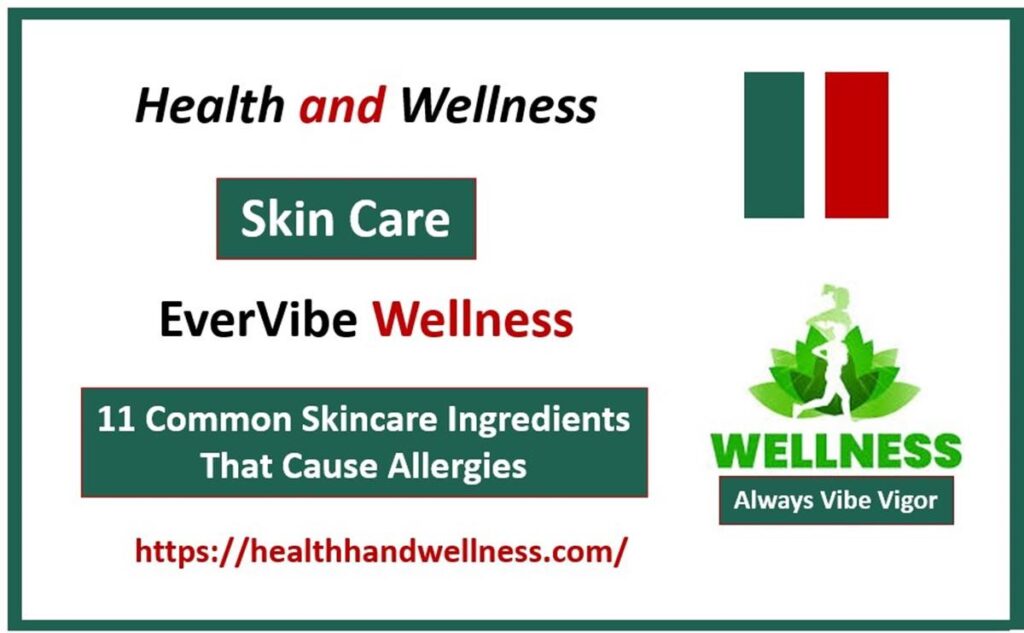Skincare allergies can be frustrating and harmful. This blog explores 11 Common Skincare Ingredients that might trigger allergic reactions, how to identify them, and tips for choosing allergy-friendly skincare. Learn how to keep your skin safe and healthy.
Introduction
Skincare has become an essential part of our daily lives. With a wide range of products promising flawless skin, it’s easy to overlook one critical factor how these products may affect sensitive skin. For individuals prone to allergies, certain ingredients in skincare products can cause redness, rashes, itching, or even more severe reactions.
This article will shed light on common allergens found in skincare products, how to spot them, and how to protect your skin from potential irritants. 11 Common Skincare Ingredients

Understanding Allergies in Skincare
Allergic reactions occur when your immune system perceives a harmless substance as a threat. When applied topically, skincare allergens can cause contact dermatitis, which manifests as redness, swelling, itching, or blistering.
Allergies are often categorized into two types:
- Irritant Contact Dermatitis: Caused by direct irritation of the skin, often by harsh chemicals.
- Allergic Contact Dermatitis: Triggered by an immune system response to specific allergens.
Both types can be caused by certain ingredients commonly found in skincare products. Let’s explore these ingredients. 11 Common Skincare Ingredients
The 11 Common Skincare Ingredients That Cause Allergies
- Fragrances
- Found in: Perfumes, moisturizers, shampoos, and lotions.
- Why it’s harmful: Fragrances are one of the leading causes of allergic contact dermatitis. Artificial or natural scents can irritate sensitive skin. Look for “fragrance-free” or “unscented” labels.
- Parabens
- Found in: Preservatives used in cosmetics and personal care products.
- Why it’s harmful: Although parabens prevent bacterial growth, they can disrupt hormones and trigger skin allergies in sensitive individuals.
- Sulfates (Sodium Lauryl Sulfate)
- Found in: Cleansers, shampoos, and toothpaste.
- Why it’s harmful: Sulfates can strip the skin of its natural oils, leading to dryness, irritation, and allergic reactions.
- Lanolin
- Found in: Moisturizers, lip balms, and baby products.
- Why it’s harmful: Although lanolin is derived from sheep’s wool and acts as a moisturizer, it can cause allergic reactions in some people, especially those with sensitive skin.
- Formaldehyde and Formaldehyde Releasers
- Found in: Nail polish, shampoos, and makeup.
- Why it’s harmful: Formaldehyde is a known skin allergen and can cause rashes, itching, and respiratory problems.
- Essential Oils
- Found in: Natural skincare products.
- Why it’s harmful: While marketed as “natural,” essential oils like lavender and tea tree oil can irritate sensitive skin and lead to allergic reactions.
- Alcohol (Denatured and Isopropyl Alcohol)
- Found in: Toners, astringents, and makeup removers.
- Why it’s harmful: Alcohol can dry out the skin, weakening its barrier and increasing the risk of irritation and allergies.
- Propylene Glycol
- Found in: Lotions, deodorants, and makeup.
- Why it’s harmful: Used as a humectant, this ingredient can irritate the skin and cause allergic reactions, especially in high concentrations.
- Artificial Colors (Dyes)
- Found in: Makeup, shampoos, and soaps.
- Why it’s harmful: Synthetic dyes, especially those derived from coal tar, can cause redness, irritation, and allergic reactions.
- Chemical Sunscreens (Oxybenzone, Avobenzone)
- Found in: Sunscreen products.
- Why it’s harmful: Chemical sunscreens absorb UV rays but can trigger allergies, especially in people with sensitive or reactive skin.
- Benzoyl Peroxide
- Found in: Acne treatments. 11 Common Skincare Ingredients
- Why it’s harmful: While effective for acne, benzoyl peroxide can cause redness, peeling, and allergic reactions in sensitive individuals.
How to Identify Skincare Allergens
- Patch Testing: Apply a small amount of the product to your inner forearm and wait 24-48 hours to see if a reaction occurs.
- Read Labels: Look for specific ingredients mentioned above and avoid them if you know they irritate your skin. 11 Common Skincare Ingredients
- Consult a Dermatologist: If you’re unsure about a product, seek professional advice to determine what works best for your skin.
- Track Reactions: Keep a journal of products you’ve used and any adverse reactions to identify patterns over time.
Tips for Choosing Allergy-Friendly Skincare
- Go Fragrance-Free: Avoid products with synthetic fragrances or perfumes.
- Choose Hypoallergenic Products: Look for labels that say “hypoallergenic” or “dermatologist-tested.”
- Stick to Minimal Ingredients: Use products with fewer ingredients to minimize the risk of irritation.
- Opt for Natural and Organic Products: While not always safer, certified organic products are less likely to contain synthetic irritants. 11 Common Skincare Ingredients
- Check Expiry Dates: Old or expired products are more likely to cause reactions.
What to Do If You Experience an Allergic Reaction
- Stop Using the Product Immediately: Discontinue use of the suspected product.
- Wash the Area: Gently cleanse the skin with water to remove any residue.
- Apply a Cold Compress: To reduce swelling and itching. 11 Common Skincare Ingredients
- Use Anti-Itch Creams: Hydrocortisone cream or antihistamines can help alleviate symptoms.
- Consult a Dermatologist: If the reaction persists or worsens, seek medical attention.
Understanding the ingredients in your skincare products is crucial for maintaining healthy, irritation-free skin. By being aware of common allergens, learning how to identify them, and making informed choices, you can avoid unwanted reactions and enjoy the benefits of skincare without worry.
Always prioritize your skin’s health by reading labels, performing patch tests, and consulting professionals when in doubt. With the right approach, you can build a skincare routine that’s both effective and allergy-friendly. 11 Common Skincare Ingredients